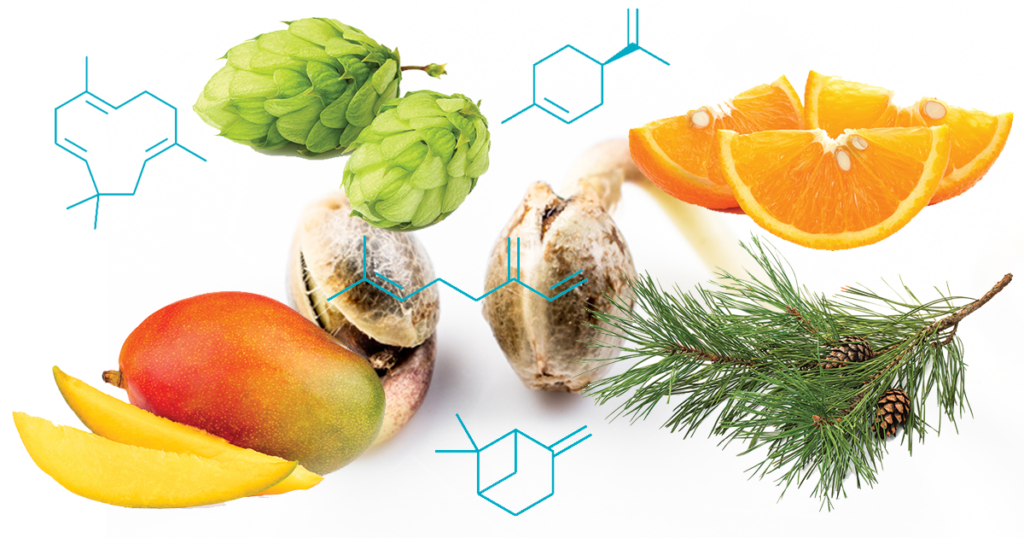We have written about it time and time again, but if you are still valuing cannabis solely based on its THC content, you are doing it wrong.
That goes for retailers and retail custies alike since the consumer can only buy whatever the shop decides to put on the shelf.
Once considered pseudo-science, the importance of the endocannabinoid system found inside each of us cannot be understated and while it may have the word cannabinoid in it, there is much more to the so-called entourage effect that we all seek from weed.
It was not until very recently that cannabis was judged based purely on its potency and the name of the strain, but advances in lab testing, along with advances in wook’s tastes, has led to a newfound appreciation for the almighty terpene.
Most cannabis aficionados can tell you by now that terps dictate what aroma and flavor are delivered by any particular cultivar, but now we know that it goes way beyond bag appeal when you’re talking terpenes.
Let’s take a look at what terpenes are and how they affect your cannabis experience.
FULL SPECTRUM CANNABIS
Have you ever dabbed some 99% THC isolate, expecting to be floored for hours, only to have the racy, heady effects vanish nearly as quickly as they came?
Or why you can take one puff of some 17% THC Blueberry cut and get knocked on your ass for hours?
Just as science has discovered that CBD “works better” when combined with THC, we know with certainty that the cannabis plant “works better” when all of its natural constituents are left in the universally balanced ratios specific to that particular cultivar or phenotype.
This is commonly referred to as the Entourage Effect – the combined power of all the plant’s healing constituents working in harmony to optimize your wellness… or make Family Guy funnier, whatever your goal is.
The more we learn about the by-products of cannabis trichomes, the more we realize that simplified categories like “Indica”, “Sativa”, or the ever-ubiquitous “Hybrid” are nearly useless at best… and can be highly misleading at worst.
Instead, lab test results for potency and purity tell a much clearer story, but there is more to it than CBD, THC, and clean grown weed.
Cannabis testing labs today have been tasked with another round of analytics and that is to determine detailed breakdowns of terpene content in your favorite flowers, concentrates, and other cannabis consumables.
Now you can discover exactly what terps are present in a batch or sample, and in what ratios they occur.
The mystery of why cannabis seems to affect everyone a little bit differently likely lies in their tolerance for terpenes.
Have you ever eaten a bowl of freshly sliced mango right before you smoked some bud? Give it a shot sometime and you will likely find that the effects of your high have been heightened even more than usual – that’s the terps working! Not just the terpenes in your cannabis, but the Myrcene in the mango as well.
While there are over 20,000 terpenes found in nature, and over 100 discovered so far as being present in the cannabis plant, the plant tends to express a select group of them more often than others.
Knowing and loving the wide variety of cannabis strains that we have encountered over the years, it is truly fascinating to realize that, yes, their cannabinoid profiles mattered, but it has been the slight skew in all of their terpene profiles that led to our acquired taste for, love for, and recognition of, hundreds of different cultivars.
Let’s look at some of the terpenes most commonly found in cannabis.
FLAVORTOWN (EFFECTSTOWN, TOO)
Functionally, terpenes play a protective role for the cannabis plant, deterring harmful pests, and luring potential pollinators.
Like a bee to the flower, seasoned cannabis consumers have learned to seek out rare, exotic, or just their own preferred terpene profiles.
This usually begins as a flavor chase, but most long-time tokers will tell you that specific terp profiles help their specific ailments. Some terpenes induce relaxation or even minor pain relief, others spark creativity and encourage physical activity.
MYRCENE
Myrcene, as we mentioned before, is a dominant terpene in mango fruit, but it is also the most commonly dominant terp found in cannabis, and most responsible for giving the plant its tell-tale aroma. With an earthy, fruity flavor and aroma, strains heavy in Myrcene tend to be more sedative, relaxing, and pain-relieving. Cultivars like Granddaddy Purp, Blue Dream, and your favorite OG are likely teeming with Myrcene terps.
LIMONENE
Known for its ability to combat anxiety and offer stress relief, Limonene smells like it sounds, bursting with citrus aromas and flavors anytime it is expressed in a phenotype. Wedding Cake was one of the hottest strains of 2020 and it can thank its lemony Limonene twist for that boost in popularity.
CARYOPHYLLENE
If you like Girl Scout Cookies crosses, you likely love the Caryophyllene terpene with its spicy, peppery, earthy flavors and aromas. Curiously, this is also the only known cannabis terp that can masquerade as a cannabinoid once ingested, self-activating the endocannabinoid system to help reduce inflammation. If your favorite strain is named after a fancy dessert, you’re probably puffing on some Caryophyllene.
PINENE
Another phonetic terp, Pinene is definitely a favorite around here, delivering that pine-forest-after-the-rain aroma and mouthwatering Kush flavor. Pinene is the most commonly occurring terpene on the planet and is used in countless industrial applications for it’s fresh, clean scent. Anxiety and minor aches and pains are not fans of Pinene, a terpene revered as much for its therapeutic qualities as it is for the boost it gives to bag appeal.
TERPINOLINE
You Jack Herer/J1 fans already know about the flavorful appeal of Terpinoline and its floral, herbal, industrial-strength cleaner aroma and heady, uplifting effects. According to Leafly.com, Terpinoline is the dominant terp in roughly 10% of all known cannabis cultivars. As far as terps are concerned, we find this one to be a bit mid-grade, sort of like your bag of Jack.
LINALOOL
If you are a lover of that bombass, dankass, purp skurp from down up north, you probably have a hankerin’ for some good ol’ fashioned Linalool terpenes. Your favorite “grape” or “purple” strains are probably packed with this lavender-like terpene known best for its stress-relieving and depression-easing effects. It is believed that Linalool, like CBD, can counteract the psychoactive “high” from potent cannabis, which would explain why a lot of folks can smoke purple weed all day long without slowing down.
BAKED
Terpenes, like cannabinoids, have specific boiling points and can undergo radical transformations when subjected to the heat of say… a lighter flame. This is why vaping dry flower or dabbing cannabis extracts tends to be such a flavorful experience compared to a blunt or a bong rip.
Terpenes also begin to change the moment that a plant is harvested, which is why you can taste a distinct difference between Live Rosin/Resin and Aged Hash or Aged Terps. Is one better than the other? That is quite literally a matter of taste.
Speaking of taste, there is a reason why The Emerald Cup began categorizing entries this year by their terpene profile. Realizing that their normally unbiased judges likely ARE biased when it comes to their favorite flavors, now each entry will be held up against buds with similar terpene profiles to determine not only what the best “fruity” or “gassy” flower is, but what the overall best terpene category is.
In the multi-millennia relationship between man and cannabis, it is about time we begin to figure out why it can offer such a different experience to different people. We know that terpenes play a role in defending and propagating the plant, and there are even studies being conducted about how they might even play a role in plant-to-plant communication.
Right now, however, the terps are talking to us and telling us it is time to puff on some Pinene-packed pot – peace!

















